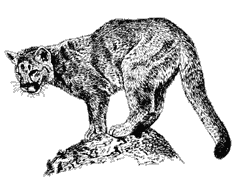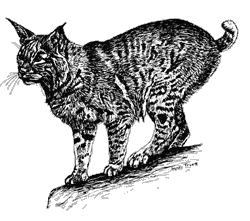Cats
Probably no other animal evokes the majesty and awe of wild North America as much as does the mountain lion. It is a massively powerful animal, yet lithe, graceful, beautiful, and mysterious.
The lion is shy and elusive, yet we know there are healthy populations of these desert phantoms because we find their tracks, scats and the remains of kills they’ve made. Most people will never see a mountain lion in the wild, however, because it is a master of camouflage, slipping behind a bush or rock or scrap of shadow and disappearing.
 |
Lions are superbly adapted predators, an essential part of the Sonoran Desert ecosystem. They are designed to efficiently kill animals larger than themselves. Lions are built with long hind legs and powerful hindquarters, which give them excellent jumping ability and thrust for great bursts of speed. They have been known to leap 23 feet in a single bound! Huge front paws with sharp claws help to grab the prey, while powerful jaws deliver the killing bite. Lions help maintain the health of deer populations by culling out the weak, sick, old, or injured.
In the Sonoran Desert lions spend their days resting in thick, brushy canyons, rocky outcrops, mine shafts, or any secluded place that provides sufficient cover.
The bobcat is both more common and more widely distributed in the Sonoran Desert than the mountain lion. It hunts smaller prey and can more easily adapt to marginal habitats. This small cat is solitary, avoiding other bobcats, and it is also careful to avoid mountain lions, which will kill it, given the chance. The bobcat is a good climber, retreating to trees for safety, but it prefers to hunt on the ground. The bobcat is mostly nocturnal; like the lion, it is secretive and shy, usually keeping to the more thickly vegetated areas and therefore not often seen by people.
Sonoran Desert species:
mountain lion (Felis concolor)
bobcat (Felis rufus)
Order: Carnivora
Family: Felidae
Spanish names: puma, león, león de la sierra (mountain lion), gato montes (bobcat)
Distinguishing Features

|
The mountain lion is the largest cat in the Sonoran Desert. A female weighs about 75 pounds, while the male can be up to 145 pounds (34 to 66 kilograms). Although the kittens have spotted coats for the first three months or so, the adult lion is a plain tawny or grayish-brown with a nearly 3 foot long, heavy, black-tipped tail. The cat itself can be over 6 feet long, with heavy legs and large feet.
The bobcat is much smaller, weighing only about 15 to 22 pounds (7 to 10 kilograms), though its long legs make it appear larger. It has broad cheek ruffs on the sides of its face and a very short tail that is black-tipped on the dorsal surface and white underneath. The bobcat usually has indistinct dark spots on its coat.
Click to hear bobcat soundsHabitat
Both cats are most common in rugged, heavily vegetated areas, but can be found in a variety of habitats, such as mountain forests, riparian canyons, and Sonoran Desert uplands. Any area that supports good prey populations will likely also have mountain lions and bobcats.
Feeding
• Diet: Both cats are carnivores. The mountain lion feeds primarily on deer, but also takes javelina, bighorn sheep, jack rabbits, porcupines, squirrels, and many other small mammals. The bobcat typically pursues smaller prey, mainly jack rabbits, cottontails, birds, snakes and rodents, but on occasion has been known to take down a deer!
• Behavior: The mountain lion may wander widely in search of deer or other prey, but when it finds something suitable, it slowly sneaks up, trying to get as close as possible before the ambush and attack. The mountain lion, though a powerful predator, has a very small heart and lungs for its size, so it lacks the endurance for long chases. A 300 yard (100 m) dash is about the best a lion can accomplish. If the deer is not caught by then, the chase is over. The lion is a very efficient predator. It often slams into the prey animal with such force that the prey is knocked off its feet. A bite to the back of the deer’s neck or to its throat ends things quickly. After feeding, the cat scrapes up leaf litter or debris to cover and hide the kill, then returns each day to feed until the prey is consumed. A single adult lion without kittens usually needs to make a kill every 6 to 10 days. In the desert a pack of coyotes is sometimes able to steal the kill from a lion, harassing the cat until it gives up and retreats.
The bobcat also hunts by ambush. Sometimes a bobcat wanders in search of prey, investigating brush piles, fallen trees, or rocky areas; at other times it waits for rabbit or rodent activity, then rushes in with a pounce and a lethal bite to the neck. Because the bobcat feeds on smaller prey, it usually has to hunt every day.
Life History
Mountain lion: Lions breed at about 2 or 3 years of age. There is no set breeding period and kittens are produced at any time of year. A male lion’s territory may overlap those of several females. He wanders continually, keeping track of the breeding status of the various females by checking urine scent markers. Normally solitary, big cats avoid each other, except when a breeding pair stays together for a few days. After a gestation period of 3 months, 3 or 4 spotted kittens are born. The kittens remain with the mother for up to a year and a half, learning how to hunt and survive. When the young cats disperse, siblings may remain together for a while to increase their hunting success before going their solitary ways. Young lions wander around searching for suitable home ranges in which to settle. Previous studies showed that these cats each had ranges of 25 square miles (65 km2) or more. Recent research has shown that lions are being crowded into ever smaller areas by human encroachment, and now several lions may occupy a much smaller area together, increasing competition, and forcing some cats into marginal areas closer to people.
Bobcat: Bobcats are also solitary, only coming together to mate in early spring. About two months later the mother bobcat seeks out a cave, a rock shelter, or even a hollow tree stump for a den and gives birth to 2 or 3 kittens. The young cats stay with the mother until the fall, hunting on her territory until they gain proficiency, then dispersing. The bobcat’s home range is only a few square miles, depending on availability of prey. If prey is scarce the cat may wander extensively. Bobcats don’t usually leave kills as evidence of their presence in an area, but they do make scrapes and mark scent posts with urine, often using the same area repeatedly.
The Story of Clyde
Many years ago Clyde, a female bobcat, was confiscated from its human owners by the Arizona Game & Fish Department and brought to the Desert Museum. She was the first bobcat to be housed in the newly completed Small Cat Habitat. But not for long. She slipped out one night and thereupon decided to be a wild, rather than a semi-tame, exhibited bobcat. Despite our efforts we could not locate her and worried about her survival. Time would prove that we were worrying needlessly.
A few weeks after Clyde’s disappearance her picture appeared in a local newspaper. She had been found in the carport of a home several miles from the Museum. Game & Fish personnel had been called, and had captured and released her in the foothills north of Tucson, where over the next few years she was seen and identified three times.
Once her timing and mine were uncanny. One day driving through the area in which she had been released, I was startled to find her atop a utility pole, having been chased there by dogs. Once the dogs were driven away, she came back down the pole where she muttered and complained in a familiar fashion when I called her name, then turned tail and disappeared into the desert.
About two years later she was sighted in the same general area leading a single kitten; and another year she was spotted with not one, but two young.
Rare Cats of the Sonoran Desert
The jaguar, jaguarundi, and ocelot reach the northern limits of their ranges in Arizona and Texas and so were probably never abundant in the United States. All three are presently listed as Endangered. Jaguars (Felis onca) have been photographed and even killed in Arizona within the last several years, but biologists believe there is no longer a breeding population of them left in the state. Jaguars are known to travel long distances, even up to 500 miles (800 km), so transient individuals may occasionally wander up from Mexico. Although water is probably not a limiting factor in the U.S. part of their range, insufficient habitat may be. Biologists studying this secretive big cat hope to learn more about its habitat preferences, as well as its habits and needs, when they can capture, radio-collar, and monitor a few animals.
Ocelots (Felis pardalis) have also been documented in Arizona, though again, loss of habitat may limit them. Ocelots prefer dense thornscrub, live oak scrub, or riparian areas with an overstory cover. In Texas, a population of 50 to 100 ocelots has been holding steady for several years, but a population that small may not have enough genetic diversity to survive indefinitely.
Jaguarundis (Felis jaguarundi) are the Sonoran Desert’s mystery cats. There are a number of jaguarundi sightings in Arizona each year, but a hide or skull has never been found, nor a photograph taken of one in the wild. Even so, some biologists believe they are present in the U.S. and are residents, since these small cats can’t travel long distances. Biologists studying these elusive cats in Mexico in areas where both ocelots and jaguarundis are common found it much easier to observe and catch ocelots.
Arizona Game & Fish Department biologists investigate and keep track of sightings of these rare cats, but caution that frequently juvenile mountain lions (with spots) and bobcats are confused with jaguars or ocelots, especially in poor light. Still, knowing that there could be a jaguar behind the next shrub or boulder makes the wilderness a much more exciting place!










